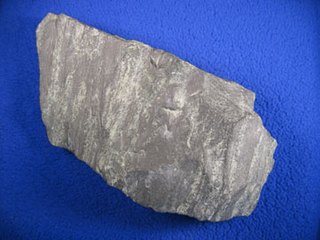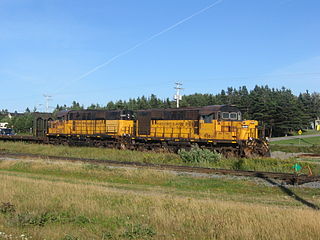
An ore is an occurrence of rock or sediment that contains sufficient minerals with economically important elements, typically metals, that can be economically extracted from the deposit. The ores are extracted from the earth through mining; they are then refined to extract the valuable element, or elements.

Taconite is a variety of iron formation, an iron-bearing sedimentary rock, in which the iron minerals are interlayered with quartz, chert, or carbonate. The name "taconyte" was coined by Horace Vaughn Winchell (1865–1923) – son of Newton Horace Winchell, the Minnesota State Geologist – during their pioneering investigations of the Precambrian Biwabik Iron Formation of northeastern Minnesota. He noted the rock had a superficial resemblance to iron-bearing rocks from the Taconic Mountains of New York state.

Wawa is a township in the Canadian province of Ontario, located within the Algoma District and associated with Wawa Lake. Formerly known as the township of Michipicoten, after a nearby river of that name, the township was officially renamed in 2007 for its largest and best-known community of Wawa.

Iron Range refers collectively or individually to a number of elongated iron-ore mining districts around Lake Superior in the United States and Canada. Despite the word "range," the iron ranges are not mountain chains, but outcrops of Precambrian sedimentary formations containing high percentages of iron. These cherty iron ore deposits are Precambrian in age for the Vermilion Range, while middle Precambrian in age for the Mesabi and Cuyuna ranges, all in Minnesota. The Gogebic Range in Wisconsin and the Marquette Iron Range and Menominee Range in Michigan have similar characteristics and are of similar age. Natural ores and concentrates were produced from 1848 until the mid 1950s, when taconites and jaspers were concentrated and pelletized, and started to become the major source of iron production.

The Wabush Lake Railway is a short line railway operating in the province of Newfoundland and Labrador, Canada.

Unorganized North Algoma District is an unorganized area in northeastern Ontario, Canada, comprising all areas in Algoma District, north of the Sault Ste. Marie to Elliot Lake corridor, which are not part of an incorporated municipality or a First Nation. It covers 44,077.03 km2 (17,018.24 sq mi) of land, and had a population of 5739 in 2016.

Schefferville is a town in the Canadian province of Quebec. Schefferville is in the heart of the Naskapi and Innu territory in northern Quebec, less than 2 km from the border with Labrador on the north shore of Knob Lake. It is located within the Caniapiscau Regional County Municipality and has an area of 25.11 square kilometres (9.70 sq mi). Schefferville completely surrounds the autonomous Innu community of Matimekosh, and it abuts the small community of Lac-John Reserve. Both of the latter communities are First Nations Innu reserves. Schefferville is also close to the Naskapi reserved land of Kawawachikamach.

The North Shore of Lake Superior runs from Duluth, Minnesota, United States, at the southwestern end of the lake, to Thunder Bay and Nipigon, Ontario, Canada, in the north to Sault Ste. Marie, Ontario, in the east. The shore is characterized by alternating rocky cliffs and cobblestone beaches, with forested hills and ridges through which scenic rivers and waterfalls descend as they flow to Lake Superior.

Sherman Mine is a closed open pit mine in Temagami, Ontario, Canada. It was a major producer of iron ore, starting production in 1968 and closing in 1990. Sherman was the largest open pit mine in Temagami, consisting of seven open pits known as the East Pit, South Pit, North Pit, West Pit and the Turtle Pits. The mine was discovered in the early part of the twentieth century, however interest was limited as a result of silver and gold discoveries in northeastern Ontario. While the Ontario government offered bounties to producers of iron ore, there was little interest in putting any iron mine into production as a result of cheaper Mesabi Range ores from the US and the Great Depression. It was only in the 1950s that Canadian steel producers started to investigate domestic supplies of iron ore. This would lead to the re-opening of the Moose Mountain Mine and development of the Adams, Sherman and Bruce Lake mines in Northern Ontario. The Sherman Mine operated in tandem with the Adams Mine in Kirkland Lake, and when the Adams Mine approached exhaustion of its economic ore reserves, the decision was made to also close the Sherman Mine. The surface infrastructure was removed and the site was abandoned. The waste piles are currently used by the municipality as a source of crushed stone for road works.

Cleator is a village in the English county of Cumbria and within the boundaries of the historic county of Cumberland.

The Gogebic Range is an elongated area of iron ore deposits located within a range of hills in northern Michigan and Wisconsin just south of Lake Superior. It extends from Lake Namakagon in Wisconsin eastward to Lake Gogebic in Michigan, or almost 80 miles. Though long, it is only about a half mile wide and forms a crescent concave to the southeast. The Gogebic Range includes the communities of Ironwood in Michigan, plus Mellen and Hurley in Wisconsin.
Lac-à-la-Tortue was a small town in the administrative region of Mauricie, in the province of Quebec, Canada. Founded in 1895, the town consisted of about 2500 inhabitants. Since January 1, 2002, Lac-à-la-Tortue has become one of the seven sectors of the new merged Shawinigan city. The Lac-à-la-Tortue area is located east of the Saint-Maurice River near the former town of Grand-Mère, east of the former city of Saint-Georges, south of Hérouxville and west of Saint-Narcisse.

Jackson Lake State Park is a 349-acre (141 ha) Ohio state park in Jackson County, Ohio, in the United States. The park was established as a state park in 1979. It had previously been a "state reserve", similar to a park but with less development. The forests in and around Jackson Lake State Park were previously harvested to fire the furnaces of numerous iron works that were located in southern Ohio in the western foothills of the Appalachian Mountains. Recreational activities available at the park include camping, boating, fishing, swimming and picnicking.

Torbrook is a community in the Canadian province of Nova Scotia, located in Annapolis County. It is located on the South Mountain of Nova Scotia's Annapolis Valley to the east of the Nictaux River.
The Ghelari mine was a large open pit, also an underground iron ore mine in the western of Romania in Hunedoara County, 20 km south-west of Hunedoara and 411 km north-west of the capital, Bucharest. Ghelari represents one of the largest iron ore reserves in Romania having estimated reserves of 14 million tonnes of ore. The mine produced around 200,000 tonnes of iron ore/year.

The Jackson Mine is an open pit iron mine in Negaunee, Michigan, extracting resources from the Marquette Iron Range. The first iron mine in the Lake Superior region, Jackson Mine was designated as a Michigan State Historic Site in 1956 and listed on the National Register of Historic Places in 1971. The Lake Superior Mining Institute said, the mine "is attractive in the iron ore region of Michigan and the entire Lake Superior region, because of the fact it was here that the first discovery of iron ore was made, here the first mining was done, and from its ore the first iron was manufactured." Multiple other mines soon followed the Jackson's lead, establishing the foundation of the economy of the entire region. The mine is located northwest of intersection of Business M-28 and Cornish Town Road.
The Quebec North Shore and Labrador Railway is a private Canadian regional railway that stretches 414 kilometres (257 mi) through the wilderness of northeastern Quebec and western Labrador. It connects Labrador City, Labrador, with the port of Sept-Îles, Quebec, on the north shore of the St. Lawrence River/Gulf of St. Lawrence. QNS&L is owned by Iron Ore Company of Canada (IOC), and is a common carrier.
The Cacova Ierii mine is a large open pit mine in the north-western of Romania in Cluj County. Cacova Ierii represents one of the largest iron ore reserves in Romania having estimated reserves of 16.6 million tonnes of ore grading 42% iron metal. The mine has the capability to produce around 415,000 tonnes of iron ore/year.
The Sheps-Perault Lake mine is a large iron mine located in east Canada in Quebec. Sheps-Perault Lake represents one of the largest iron ore reserves in Canada and in the world having estimated reserves of 4.38 billion tonnes of ore grading 30.5% iron metal.

Kostomuksha Nature Reserve is a Russian 'zapovednik' of forests, lakes, rivers and wetlands on the border of Russian and Finland. It was created in 1983, along with other protected areas, in part to mitigate the impact of the Karelskiy Okatysh mine outside of the town of Kostomuksha, one of the largest iron ore reserves in Russia, and also to protect the forest from increase commercial logging in the area. A further scientific purpose is the protection of forest reindeer and a type of landlocked salmon. The reserve is part of a transboundary reserve complex with reserves in Finland to the west, and is situated in the Kalevalsky District and Muyezersky District of the Republic of Karelia, about 500 km north of St. Petersburg and 500 km west of Arkhangelsk. The reserve was created in 1993, and covers an area of 47,569 ha (183.66 sq mi).
















